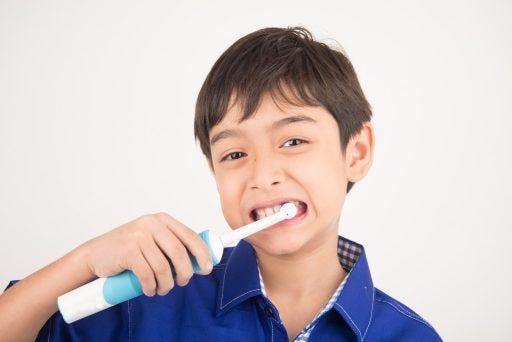Brushing your teeth twice daily is the bare minimum of good oral hygiene. It is not just about scrubbing your teeth. You have to master the technique, use the best toothpaste for your needs, and even find the right toothbrush – especially with the available options. Are you happy with your standard plastic variety, or do you want to shift to a bamboo handle? Or is electric toothbrush better? Does it even matter?
Read this article to learn the differences between “manual” and electric toothbrushes. Hopefully, you can decide your best option based on your needs and budget.
Pros of Manual Toothbrushes

Manual toothbrushes have stood the test of time for a reason – you can find them virtually anywhere. But more than that, they’re just so reliable.
Manual toothbrushes are handy.
They are light and portable. You don’t need batteries, a charger, or a set of instructions – just running water and some toothpaste. You can effortlessly bring your toothbrush to work, the gym, or the plane so you can make good on your dental care anytime, anywhere.
They’re cost-effective.
Electric toothbrushes cost a pretty penny. While you can’t say they’re disposable, you still have to replace the brush heads now and then – which is probably around the same frequency you need to throw out your toothbrush for a new one. (According to studies, you must switch every three months.) Since manual toothbrushes are so cheap, you won’t feel too bummed if you lose or forget them. You can easily buy another one – or even buy in bulk!
Manual toothbrushes are everywhere.
You can pick up a toothbrush from any convenience store or petrol station. You could ask for one from the hotel concierge – if your room doesn’t offer one already. You may even tap a friend on the shoulder to check if they have an extra one.
Cons of Manual Toothbrushes
Manual toothbrushes may be low maintenance, but they do have some drawbacks.
They are less effective.
In terms of how good they are at cleaning your teeth, manual toothbrushes tend to fall slightly lower behind electric toothbrushes. Since mobility is limited, hard-to-reach areas don’t get the attention they need, making you more prone to cavities and tooth decay. Moreover, analogue brushes won’t be as effective if you don’t have that technique down.
They are more abrasive.
A paper in Clinical Oral Investigations states that people who use manual toothbrushes are likelier to brush too hard. Overbrushing may damage your gums and your teeth’s enamel. Remember to scrub gently and firmly, using circular motions instead of going back and forth.
They may decrease brush time.
Brushing thoroughly takes around two minutes. Electric toothbrushes usually have a built-in timer that guarantees you commit to cleaning every crack and crevice of your mouth. You can always get a separate timer when using your manual toothbrush, but not everyone has the time (or patience) for an extra step.
Pros of Electric Toothbrushes

The main difference between electric toothbrushes and manual ones is their engineering. Electric toothbrushes have bristles that vibrate and rotate, cleaning your teeth using micro-movements you won’t find from conventional versions. Sounds good, right? Here are other benefits of these high-tech tools.
They prevent more dental problems.
An experiment conducted for over 11 years shows that individuals who used electric toothbrushes had less gum disease, tooth loss, and better overall oral health than those who used manual toothbrushes.
Another study, “Power Versus Manual Toothbrushing for Oral Health,” supports these findings, stating that power brushing, which is when you use the electric variety, is more effective at removing plaque and preventing gingivitis. You should know, however, that proper manual brushing coupled with flossing, can also clean your teeth. But you might need to put some elbow grease into it.
They promise a deeper clean.
An electric toothbrush might be a better option for those who wear braces. Increased mobility and movement from oscillating bristles will reach the cramped spaces between wires and brackets, assuring brace-wearers of a more effective clean.
They are easier for children and seniors.

Certain age groups might benefit from electric toothbrushes more. For example, those with a toddler know that toothbrush time can be a tiresome experience. Investing in an electric toothbrush for kids is a fun way to get your mini-me to brush with the novelty of moving bristles and a timer. Some even play songs that end when brushing time is over.
Not only will an electric toothbrush put an end to your bedtime clean-up battle, but it will also empower your children to be independent as they learn to brush their teeth themselves.
Although your granny might not exactly get a kick out of tunes from a toothbrush, she might enjoy the ease of not exerting too much effort to grip an electric toothbrush. Those with dexterity issues might have an easier time power brushing instead of dealing with the strain of holding a manual toothbrush.
Cons of Electric Toothbrushes
Off the bat, choosing a fancy space-age electric toothbrush might seem like a no-brainer. But you must consider the cost and maintenance of owning one.
They are more expensive than manual toothbrushes.
Depending on the brand, an electric toothbrush can cost up to four times more than a manual toothbrush. Don’t forget the brush heads, which need replacing four times a year. Should you be okay with these factors, choose a kind with a sonic brush head that vibrates back and forth extremely fast, allowing the bristles to get further between your teeth.
They have more movable parts.
Multifunctional electric toothbrushes come with parts that require assembly and charging. It entails higher maintenance, which may not bode well for those who prefer a no-frills style.
Do dentists recommend an electric toothbrush or a manual one? A manual toothbrush is cheaper and more convenient, while an electric toothbrush has features that make brushing easier for specific age groups.
But total oral care doesn’t end with your toothbrush. For example, those with crooked teeth will always be more prone to cavities and decay. Straightening your pearly whites might be a better solution in the long run. Using a premier dental aligner, such as ClearCorrect, can fix your teeth subtly and conveniently. Because you can remove them, you’re free to brush your teeth thoroughly, no matter what kind of toothbrush you use.
Whether you’re sold on electric toothbrushes or want to stick to manual, remember that brushing is only one aspect of oral hygiene. When you don’t forget to brush, floss, and visit your dentist regularly, you’ll realise that the best toothbrush is the one you choose to use, well, properly.
References:
An investigation into the effect of three months’ clinical wear on toothbrush efficacy: results from two independent studies. (2003). PubMed.
Pitchika, V., Pink, C., Völzke, H., Welk, A., Kocher, T. D., & Holtfreter, B. (2019). Long‐term impact of powered toothbrush on oral health: 11‐year cohort study. Journal of Clinical Periodontology.
Wiegand, A., Burkhard, J. P. M., Eggmann, F., & Attin, T. (2013). Brushing force of manual and sonic toothbrushes affects dental hard tissue abrasion. Clinical Oral Investigations, 17(3), 815–822.
Yaacob, M., Worthington, H. V., Deacon, S. A., Deery, C., Walmsley, A., Robinson, P. N., & Glenny, A. (2014). Powered versus manual toothbrushing for oral health. The Cochrane Library, 2014(6).



